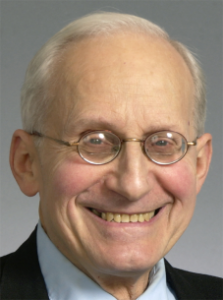MIMO Radars and Their Conventional Equivalents
244 Wood Street
Lexington, MA 02421
USA
Aerospace and Electronic Systems, AP and MTT – 6:00PM, Thursday, 26 February
MIMO Radars and Their Conventional Equivalents – Dr. Eli Brookner, Raytheon Company (retired)
This talk is given in tutorial form to benefit those not familiar with MIMO. It gives physical insight into MIMO and its conventional equivalents. The math will be limited to the basic Fourier Transform which we all learned in undergraduate college. At this talk a new conventional array radar is presented which gives the SAME orders of magnitude accuracy and resolution as a MIMO array radar and has no grating lobes. It is also shown that a MIMO array radar does not do any better in rejecting all classes of jammers than a conventional radar.
This talk is given in tutorial form for the benefit of those not familiar with MIMO. The aim is to give physical insight into MIMO and its conventional equivalents. The math will be limited to the basic Fourier Transform which we all learned in undergraduate college. We will start with an explanation of MIMO and conventional arrays. It had been shown by the speaker that contrary to common belief a MIMO full/thin array does not provide orders of magnitude better resolution and accuracy (10x, 100x or 1000x better) than a conventional array. Specifically, It was shown that that a conventional full/thin array can do just as well as a MIMO full/thin array. The conventional full/thin array had some grating lobes (GLs) but these were dealt with. Here a new conventional array that does not have GLs but has the SAME accuracy and resolution as the MIMO full/thin array is presented. It is a conventional thin/full array radar which is the conventional full/thin array radar with the roles of the arrays reversed, thin array transmitting and full array receiving. It is also shown that conventional equivalents to MIMO radar systems can do just as well as the MIMO systems in rejecting barrage-noise jammers, repeater jammers, hot-clutter jammers and main-lobe jammers. Signal processing loads, waveforms and the operation of the MIMO and its equivalents are detailed.
This meeting begins at 6:00 PM Thursday, February 26, 2015 and will be located in the cafeteria at MIT Lincoln Laboratory, 244 Wood Street, Lexington, MA 02420, use the Wood St. entrance. The meeting is free and open to the public. All are welcome. Prior to the seminar there will be social time and networking from 5:30 – 6:00PM. For more information Antennas & Propagation chair, Raoul O. Ouedraogo,raoul.ouedraogo@ll.mit.edu., or visit the Boston IEEE Society website at https://ieeeboston.org/. For directions please see: http://www.ll.mit.edu/about/map.html
All attendees must present a valid driver’s license to MIT Lincoln Laboratory (LL) security. To get to the Cafeteria, proceed toward the Main Entrance of LL from the parking lot. Before entering the building, proceed down the stairs located to the left of the LL Main Entrance. Turn right at the bottom of the stairs and enter the building through the Cafeteria entrance. The Cafeteria is located directly ahead.
Brookner Bio; 5-9-14
BEE: The City College of the City of New York, ’53, MEE and DrSc: Columbia University ’55 and ’62.
Dr. Eli Brookner worked at Raytheon Company from 1962 to retirement July 2014. There he was a Principal Engineering Fellow and worked on ASDE-X airport radar, ASTOR Air Surveillance Radar, RADARSAT II, Affordable Ground Based Radar (AGBR), major Space Based Radar programs, NAVSPASUR S-Band upgrade, COBRA DANE, PAVE PAWS, Missile Site Radar (MSR), COBRA JUDY Replacement, THAAD, Brazilian SIVAM, SPY-3, Patriot, BMEWS, UEWR, Surveillance Radar Program (SRP), Pathfinder marine radar, Long Range Radar (upgrade for >70 ATC ARSRs), COBRA DANE Upgrade, AMDR, Space Fence, 3DELRR, FAA NexGen ATC radar program. Prior to Raytheon he worked on radar at Columbia University Electronics Research Lab. (now RRI), Nicolet and Rome AF Lab.
Received IEEE 2006 Dennis J. Picard Medal for Radar Technology & Application “For Pioneering Contributions to Phased Array Radar System Designs, to Radar Signal Processing Designs, and to Continuing Education Programs for Radar Engineers”; IEEE ’03 Warren White Award; Journal of the Franklin Institute Premium Award for best paper award for 1966; IEEE Wheeler Prize for Best Applications Paper for 1998. Fellow of IEEE, AIAA, MSS. Member of the National Academies Panel on Sensors and Electron Devicesfor Review of Army Research Laboratory Sensors and Electron Devices Directorate (SEDD)
Published four books: Tracking and Kalman Filtering Made Easy, John Wiley and Sons, Inc., 1998; Practical Phased Array Antenna Systems (1991), Aspects of Modern Radar (1988), and Radar Technology (1977), Artech House. Gives courses on Radar, Phased Arrays and Tracking around the world (25 countries). Over 10,000 attended these courses. Banquet/keynote speaker twelve times. >230 papers, talks and correspondences, >100 invited. Six paper reprinted in Books of Reprints (one in two books). Contributed chapters to three books. Nine patents.
To assist us better plan this meeting, please pre-register at http://www.ieeeboston.org/Register/.

